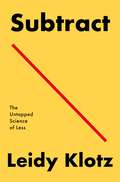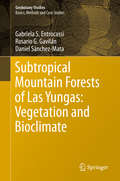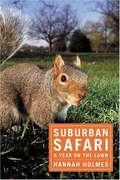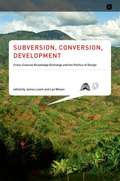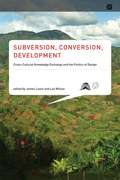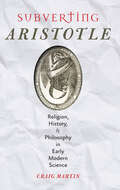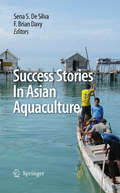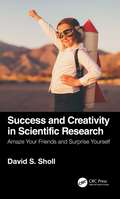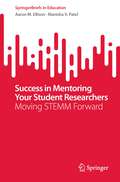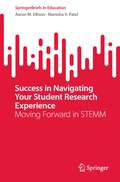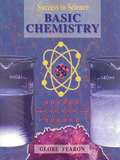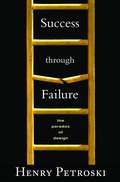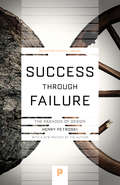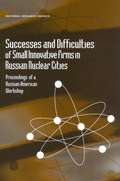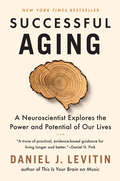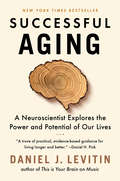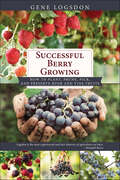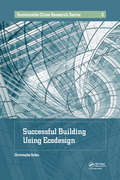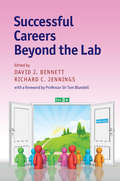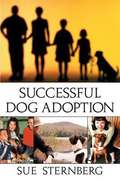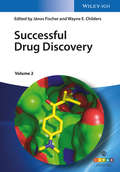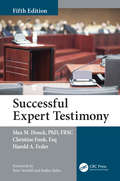- Table View
- List View
Subtract: The Untapped Science of Less
by Leidy KlotzBlending evidence across science and design, Subtract: The Untapped Science of Less offers a revolution in problem-solving: proving why we overlook subtraction, and how we can access its true potentialWe pile on “to-dos” but don’t consider “stop-doings.” We create incentives for good behavior, but don’t get rid of obstacles to it. We collect new-and-improved ideas, but don’t prune the outdated ones. Every day, across challenges big and small, we neglect a basic way to make things better: we don’t subtract.Leidy Klotz’s pioneering research shows why. Whether we’re building Lego models or cities, grilled-cheese sandwiches or strategic plans, our minds tend to add before taking away. Even when we do think of it, subtraction can be harder to pull off because an array of biological, cultural, and economic forces push us towards more. But we have a choice—our blind spot need not go on taking its toll on our cities, our institutions, and our minds. By diagnosing our neglect of subtraction, we can treat it. Subtract will change how you change your world. In these pages you’ll meet subtracting exemplars: design geniuses, Nobel Prize-winners, rock-stars, and everyday heroes, who have subtracted to dismantle racism, advance knowledge, heal the planet, and even tell better jokes. These and more guiding lights show how we can revolutionize not just our day-to-day lives, but our collective legacy. A paradigm shift of a book, Subtract shows us how to find more of the options we’ve been missing—and empowers us to pursue them.
Subtropical Mountain Forests of Las Yungas: Vegetation and Bioclimate (Geobotany Studies)
by Gabriela S. Entrocassi Rosario G. Gavilán Daniel Sánchez-MataThe vegetation addressed in this book is, biologically, one of the most diverse on Earth, with many characteristic taxa offering refuge and food sources for many resident and migratory animals. Yet the forests of Las Yungas remain poorly known from a floristic and vegetation point of view. This book seeks to fill that gap by studying the distribution of forest along an altitudinal but also a bioclimatic gradient. The richness in species demonstrates that these forests are substantially more diverse than other subtropical mountain woodlands. 103 diagnostic (characteristic or indicator) species were selected, of which 29 are dominant, 67 are exclusive, selective, preferential or differential, and 7 are stenoic. In addition, 13 communities were identified and characterized. These forests can be attributed to the Bolivian-Tucuman biogeographical province (South-Andean Region, Neotropical Sub-Kingdom). They are seasonal, semi-deciduous or evergreen micro- and mesowoodlands growing on foothills, hillsides, ravines, gorges and the edges of mountain ranges (terrestrial communities), as well as river terraces and beaches (riparian communities). Thanks to the range of new findings, the content presented here will benefit experts in related fields such as geographers, ecologists and botanists, but also teachers, nature guides, those involved in the management of forest or conservation areas, and policymakers.
Suburban Safari
by Hannah HolmesA scientist spends a year in the (suburban) jungle, providing us an intimate look at the critters in our very backyards.
Subversion, Conversion, Development
by James Leach Lee WilsonThis book explores alternative cultural encounters with and around information technologies. These encounters are alternative because they counter dominant, Western-oriented notions of media consumption; they include media practices as forms of cultural resistance and subversion, "DIY cultures," and other nonmainstream models of technology production. The contributors -- leading thinkers in science and technology studies, anthropology, and software design -- pay special attention to the specific inflections that different cultures and communities give to the value of knowledge. The richly detailed accounts presented here challenge the dominant view of knowledge as a neutral good -- information available for representation and encoding but separated from all social relations. The chapters examine specific cases in which the forms of knowledge and cross-cultural encounters are shaping technology use and development. They consider design, use, and reuse of technological tools, including databases, GPS devices, books, and computers, in locations that range from Australia and New Guinea to Germany and the United States. ContributorsPoline Bala, Alan Blackwell, Wade Chambers, Michael Christie, Hildegard Diemberger, Stephen Hugh-Jones, James Leach, Jerome Lewis, Dawn Nafus, Gregers Petersen, Marilyn Strathern, David Turnbull, Helen Verran, Laura Watts, Lee Wilson
Subversion, Conversion, Development
by James Leach Lee WilsonThis book explores alternative cultural encounters with and around information technologies. These encounters are alternative because they counter dominant, Western-oriented notions of media consumption; they include media practices as forms of cultural resistance and subversion, "DIY cultures," and other nonmainstream models of technology production. The contributors -- leading thinkers in science and technology studies, anthropology, and software design -- pay special attention to the specific inflections that different cultures and communities give to the value of knowledge. The richly detailed accounts presented here challenge the dominant view of knowledge as a neutral good -- information available for representation and encoding but separated from all social relations. The chapters examine specific cases in which the forms of knowledge and cross-cultural encounters are shaping technology use and development. They consider design, use, and reuse of technological tools, including databases, GPS devices, books, and computers, in locations that range from Australia and New Guinea to Germany and the United States. ContributorsPoline Bala, Alan Blackwell, Wade Chambers, Michael Christie, Hildegard Diemberger, Stephen Hugh-Jones, James Leach, Jerome Lewis, Dawn Nafus, Gregers Petersen, Marilyn Strathern, David Turnbull, Helen Verran, Laura Watts, Lee Wilson
Subverting Aristotle: Religion, History, and Philosophy in Early Modern Science
by Craig MartinHow new thinking about history, evidence, and scientific authority depended on undermining the authority of Aristotelianism."The belief that Aristotle’s philosophy is incompatible with Christianity is hardly controversial today," writes Craig Martin. Yet "for centuries, Christian culture embraced Aristotelian thought as its own, reconciling his philosophy with theology and church doctrine. The image of Aristotle as source of religious truth withered in the seventeenth century, the same century in which he ceased being an authority for natural philosophy." In this fresh study of the complicated origins of revolutionary science in the age of Bacon, Hobbes, and Boyle, Martin traces one of the most important developments in Western European history: the rise and fall of Aristotelianism from the eleventh to the eighteenth century.Medieval theologians reconciled Aristotelian natural philosophy with Christian dogma in a synthesis that dominated religious thought for centuries. This synthesis unraveled in the seventeenth century contemporaneously with the emergence of the new natural philosophies of the scientific revolution. Important figures of seventeenth-century thought strove to show that the medieval appropriation of Aristotle defied the historical record that pointed to an impious figure of dubious morality. While numerous scholars have written on the seventeenth-century downfall of Aristotelianism, almost all of those works have examined how the conceptual content of the new sciences—such as the heliocentric cosmology, atomism, mechanical and mathematical models, and experimentalism—were used to dismiss the views of Aristotle. Subverting Aristotle is the first to focus on the religious polemics accompanying the scientific controversies that led to the eventual demise of Aristotelian natural philosophy.Martin’s thesis draws extensively on primary source material from England, France, Italy, Germany, and the Netherlands. It alters present perceptions not only of the scientific revolution but also of the role of Renaissance humanism in the forging of modernity.
Success Stories in Asian Aquaculture
by F. Brian Davy Sena S. De SilvaThe stories presented in Success Stories in Asian Aquaculture reflect the unique nature of Asian aquaculture, providing first-time insight into how and why it has become so successful. Overall, the book demonstrates how the resilience, adaptability, and innovation of small-scale aquaculture farmers have been crucial to this success. It also places aquaculture development in Asia into a wider global context, and describes its relationship to natural systems, social conditions, and economics. The book is unique in its in-depth presentation of primary research on Asian aquaculture, and in demonstrating how aquaculture can have a lasting positive impact on livelihoods, food security, and sustainable development. This book will appeal to a wide range of readers. The introduction and conclusion give an excellent general overview of Asian aquaculture, and the individual case studies provide a wealth of new information for specialist readers. Researchers, development workers, and decision-makers, in particular, will be interested in how the Asian experience might be used to strengthen aquaculture development more generally and in other parts of the developing tropics of Latin America and Africa.
Success and Creativity in Scientific Research: Amaze Your Friends and Surprise Yourself
by David S. ShollLong-term success in scientific research requires skills that go well beyond technical prowess. Success and Creativity in Scientific Research: Amaze Your Friends and Surprise Yourself is based on a popular series of lectures the author has given to PhD students, postdoctoral researchers, and faculty at the Georgia Institute of Technology. Both entertaining and thought-provoking, this essential work supports advanced students and early career professionals across a variety of technical disciplines to thrive as successful and innovative researchers. Features: Discusses habits needed to find deep satisfaction in research, systematic and proven methods for generating good ideas, strategies for effective technical writing, and making compelling presentations Uses a conversational tone, making extensive use of anecdotes from scientific luminaries to engage readers Provides actionable methods to help readers achieve long-term career success Offers memorable examples to illustrate general principles Features topics relevant to researchers in all disciplines of science and engineering This book is aimed at students and early career professionals who want to achieve the satisfaction of performing creative and impactful research in any area of science or engineering.
Success and Suppression
by Dag Nikolaus HasseDag Nikolaus Hasse shows how ideological and scientific motives led to the decline of Arabic traditions in European culture. The Renaissance was a turning point: on the one hand, Arabic scientific traditions reached their peak of influence in Europe; on the other, during this period the West began to forget, or suppress, its debt to Arabic culture.
Success in Mentoring Your Student Researchers: Moving STEMM Forward (SpringerBriefs in Education)
by Aaron M. Ellison Manisha V. PatelThis book is a guide for mentors on how to recruit, mentor, and support students through a student research experience in science, technology, engineering, mathematics, and medicine (STEMM) fields. Being a successful research mentor benefits from the self-awareness and planning, strategies and skills that Success in Mentoring your Student Researchers can help you build and develop. These are useful for mentors working with any students, but especially those who have been minoritized in STEMM or are the first in their family to attend college. The first part of the book introduces mentoring undergraduates and how it differs from traditional classroom instruction, active learning, and flipped classrooms; mentoring is collaboratively teaching research while doing research. A mentored undergraduate research experience also helps your mentees develop the skills necessary to be successful scientists and become part of STEMM communities. The central part of the book presents the undergraduate research experience as a “three-legged stool” whose legs—research, education, and community—each have unique values in advancing your mentees’ path in STEMM and all of which require setting, communicating, and realizing expectations for “success”--your mentees’ and your own. The last part of the book looks beyond the research experience, from evaluating your success as a mentor through helping your mentees to continue to develop and grow their STEMM careers and become mentors themselves. This book is the mentor’s companion to the authors’ book for students, “Success in Navigating your Student Research Experience: Moving Forward in STEMM.”
Success in Navigating Your Student Research Experience: Moving Forward in STEMM (SpringerBriefs in Education)
by Aaron M. Ellison Manisha V. PatelThis book is a complete guide for students on how to make the most of intensive, experiential research outside a college classroom. Engaging in research as an undergraduate can lead to successful and rewarding careers in science, technology, engineering, mathematics, and medicine (STEMM). Being successful in an undergraduate research experience benefits from the self-awareness and planning, strategies and skills that Success in Navigating your Student Research Experience can help you build and develop. The first part of this book describes strategies and processes for finding, applying, and preparing for an undergraduate research experience that matches your own needs and interests. These strategies are useful for any student, but are particularly helpful for individuals who have been minoritized in STEMM or are the first in their family to attend college. The central part of the book presents the undergraduate research experience as a “three-legged stool” whose legs—research, education, and community—each have unique values in advancing your path in STEMM. The last part of the book illustrates the many options for continuing and expanding your path in research. These range from communicating results to colleagues to moving forward with graduate studies and careers in STEMM, in which you can become a mentor to the next generation of students.This book is the student’s companion to the authors’ book for mentors, “Success in Mentoring your Student Researchers: Moving STEMM Forward.”
Success in Science: Basic Chemistry
by Globe FearonSuccess in Science: Basic Chemistry provides critical test-preparation strategies for all ability levels. This book helps students reading below grade level develop the science content knowledge they need to succeed in class and on standardized tests.
Success through Failure
by Henry PetroskiDesign pervades our lives. Everything from drafting a PowerPoint presentation to planning a state-of-the-art bridge embodies this universal human activity. But what makes a great design? In this compelling and wide-ranging look at the essence of invention, distinguished engineer and author Henry Petroski argues that, time and again, we have built success on the back of failure--not through easy imitation of success.Success through Failure shows us that making something better--by carefully anticipating and thus averting failure--is what invention and design are all about. Petroski explores the nature of invention and the character of the inventor through an unprecedented range of both everyday and extraordinary examples--illustrated lectures, child-resistant packaging for drugs, national constitutions, medical devices, the world's tallest skyscrapers, long-span bridges, and more. Stressing throughout that there is no surer road to eventual failure than modeling designs solely on past successes, he sheds new light on spectacular failures, from the destruction of the Tacoma Narrows Bridge in 1940 and the space shuttle disasters of recent decades, to the collapse of the World Trade Center in 2001. Petroski also looks at the prehistoric and ancient roots of many modern designs. The historical record, especially as embodied in failures, reveals patterns of human social behavior that have implications for large structures like bridges and vast organizations like NASA. Success through Failure--which will fascinate anyone intrigued by design, including engineers, architects, and designers themselves--concludes by speculating on when we can expect the next major bridge failure to occur, and the kind of bridge most likely to be involved.
Success through Failure: The Paradox of Design (Princeton Science Library)
by Henry PetroskiDesign pervades our lives. Everything from drafting a PowerPoint presentation to planning a state-of-the-art bridge embodies this universal human activity. But what makes a great design? In this compelling and wide-ranging look at the essence of invention, distinguished engineer and author Henry Petroski argues that, time and again, we have built success on the back of failure--not through easy imitation of success. Success through Failure shows us that making something better--by carefully anticipating and thus averting failure--is what invention and design are all about. Petroski explores the nature of invention and the character of the inventor through an unprecedented range of both everyday and extraordinary examples--illustrated lectures, child-resistant packaging for drugs, national constitutions, medical devices, the world's tallest skyscrapers, long-span bridges, and more. Stressing throughout that there is no surer road to eventual failure than modeling designs solely on past successes, he sheds new light on spectacular failures, from the destruction of the Tacoma Narrows Bridge in 1940 and the space shuttle disasters of recent decades, to the collapse of the World Trade Center in 2001. Petroski also looks at the prehistoric and ancient roots of many modern designs. The historical record, especially as embodied in failures, reveals patterns of human social behavior that have implications for large structures like bridges and vast organizations like NASA. Success through Failure--which will fascinate anyone intrigued by design, including engineers, architects, and designers themselves--concludes by speculating on when we can expect the next major bridge failure to occur, and the kind of bridge most likely to be involved.
Successes and Difficulties of Small Innovative Firms in Russian Nuclear Cities: Proceedings of a Russian-American Workshop
by Committee on Small Innovative Firms in Russian Nuclear CitiesThis workshop report focuses on successes and failures of small innovative firms in five science cities in Russia. The workshop was organized by the NRC with the cooperation of Minatom.
Successful Aging: A Neuroscientist Explores the Power and Potential of Our Lives
by Daniel LevitinAuthor of the iconic bestsellers This Is Your Brain on Music and The Organized Mind, Daniel Levitin turns his keen insights to what happens in our brains as we age; why we should think about health span, not life span; and, based on a rigorous analysis of neuroscientific evidence, how you can make the most of your seventies, eighties, and nineties today, no matter how old you are now. <P><P>Successful Aging uses research from developmental neuroscience and the psychology of individual differences to show that sixty-plus years is a unique developmental stage that, like infancy or adolescence, has its own demands and distinct advantages. Levitin looks at the science behind what we can all learn from those who age joyously, as well as how to adapt our culture to take full advantage of older people's wisdom and experience. Throughout his exploration of what aging really means, Levitin reveals resilience strategies and practical, cognitive enhancing tricks everyone can do as they age. <P><P>This book is packed with accessible and discussable takeaways, providing great material for reading groups and media coverage. <P><P>Successful Aging inspires a powerful new approach to how readers think about our final decades, and it will revolutionize the way we plan for old age as individuals, family members, and citizens within a society where the average life expectancy continues to rise. <P><P><b>A New York Times Bestseller</b>
Successful Aging: A Neuroscientist Explores the Power and Potential of Our Lives
by Daniel LevitinAuthor of the iconic bestsellers This Is Your Brain on Music and The Organized Mind, Daniel Levitin turns his keen insights to what happens in our brains as we age, why we should think about health span, not life span, and, based on a rigorous analysis of neuroscientific evidence, what you can do to make the most of your seventies, eighties, and nineties today no matter how old you are now. Successful Aging uses research from developmental neuroscience and the psychology of individual differences to show that sixty-plus years is a unique developmental stage that, like infancy or adolescence, has its own demands and distinct advantages. Levitin looks at the science behind what we all can learn from those who age joyously, as well as how to adapt our culture to take full advantage of older people's wisdom and experience. Throughout his exploration of what aging really means, Levitin reveals resilience strategies and practical, cognitive enhancing tricks everyone should do as they age. The book is packed with accessible and discussable takeaways, providing great material for reading groups and media coverage. Successful Aging inspires a powerful new approach to how readers think about our final decades, and it will revolutionize the way we plan for old age as individuals, family members, and citizens within a society where the average life expectancy continues to rise.
Successful Agricultural Innovation in Emerging Economies
by Richard C. Jennings David J. BennettWorld population is forecast to grow from 7 to 9 billion by 2050, 1 in 6 is already hungry and food production must increase by 70-100% if it is to feed this growing population. No single solution will solve this problem but recent developments in the genetic technologies of plant breeding can help to increase agricultural efficiencies and save people from hunger in a sustainable manner, particularly in African nations where the need is greatest. These advances can rapidly incorporate new traits and tailor existing crops to meet new requirements and also greatly reduce the time and costs taken to improve local crop varieties. This book provides a collected, reliable, succinct review which deals expressly with the successful implementation of the new plant genetic sciences in emerging economies in the context of the interrelated key regulatory, social, ethical, political and trade matters.
Successful Berry Growing: How to Plant, Prune, Pick and Preserve Bush and Vine Fruits
by Gene LogsdonA garden without berries is like spring without flowers. But with ever-increasing prices at grocery stores and markets, berries have sadly become a rare treat for most people. Successful Berry Growing is a book to solve this problem for good! A lifelong organic farmer, homesteader and student of everything agricultural, Gene Logsdon knows a thing or two about growing berries. And although Successful Berry Growing is geared to the small-scale or family operation, the information inside is useful for growing berries on any scale. You'll learn how to: Optimize your soil for berry growing Choose the right berry varieties for your climate Properly plant and prune your berry plants Keep your plants healthy and disease-free With detailed information on cultivating strawberries, raspberries, blueberries, blackberries, grapes, currants, gooseberries, cranberries, elderberries, huckleberries and more, Successful Berry Growing is all you need to grow nature's most delicious candy in your own backyard!
Successful Building Using Ecodesign (Sustainable Cities Research Series #1)
by Christophe GobinThe notion of ecodesign has now clearly become part of the building sector. It involves taking into consideration environmental issues that are indispensible in constructing our living environment. However, this method, which is industrial in origin, clearly shows that buildings are not the result of simply adding up technical rules. A much more demanding process underpins their development, one that engages all stakeholders in the industry and leads them towards using a new practice involving multi-criteria choices that are never unique. The object of this work is to review each of the stages in a building operation to illustrate the necessity of optimization and to observe the useful contribution that ecodesign and its tools can make. Ecodesign has been tackled from the professional point of view of those involved in construction work. In this perspective, the central tool is clearly that of the life cycle analysis (LCA). This book therefore describes the different steps of a project management cycle in accordance with a functional analysis. The product achievement is evaluated with the life cycle analysis which can be used as a measurement of its efficiency.
Successful Careers beyond the Lab
by Richard C. David J. Bennett JenningsThere is a major demand for people with scientific training in a wide range of professions based on and maintaining relations with science. However, there is a lack of good first-hand information about alternative career paths to research. From entrepreneurship, industry and the media to government, public relations, activism and teaching, this is a readable guide to science based skills, lifestyles and career paths. The ever-narrowing pyramid of opportunities within an academic career structure, or the prospect of a life in the laboratory losing its attraction, mean that many who trained in science and engineering now look for alternative careers. Thirty role models who began by studying many different disciplines give personal guidance for graduates, postgraduates and early-career scientists in the life sciences, physical sciences and engineering. This book is an entertaining resource for ideas about, and directions into, the many fields which they may not be aware of or may not have considered.
Successful Dog Adoption
by Sue SternbergFrom the Book jacket: EXPERT GUIDANCE IN CHOOSING THE RIGHT DOG -THE FIRST TIME Written by a renowned expert in shelter adoption, Successful Dog Adoption delivers all the information you need to find the perfect dog at a shelter and make him part of your family. In easy-to understand language, Sue Sternberg helps you decide if you're ready to adopt by evaluating your reasons and translating them into what you should look for in a particular dog. She shows you how to find a reputable shelter, prepare for the adoption process, and work with shelter personnel to make sure they have appropriately screened their dogs. You'll also learn about "rescue" dog and why one might be right for you. This practical guide covers all the vital issues you need to consider when adopting-choosing a male or female, a puppy or an adult; identifying fearful dogs or dogs who will bite; and seeking out a dog with the ideal temperament. Featured here are detailed tests and observations used by professionals to ascertain the temperament and compatibility of shelter dogs-now made available to the public for the first time. You'll discover how to determine risk factors in an unknown dog, gauge a dog's potential reaction to guests and strangers, and predict the compatibility level when you add another dog to your household. This book also offers invaluable advice on training your new pet, including guidance in housebreaking, selecting a training class, and helping a dog who gets carsick or doesn't like to be home alone. And, if you still experience difficulties with your dog, Sternberg gently discusses the step you can take. Authoritative and friendly, Successful Dog Adoption is the one-stop guide for finding your own "superdog"-and keeping the dog-owner relationship fresh and rewarding for years to come. SUE STERNBERG is one of the foremost authorities on successful shelter adoption in the United States, with more than 23 years of canine behavior experience. She is the Executiv Director of the Community Animal Shelter Association (CASA), a not-for-profit organization dedicated to pet owner outreach, safe animal adoptions, and quality-of-life issues at animal shelters around the world. Her extraordinary work with dogs is the subject of a Winter 2000 HBO documentary, Shelter Dogs.
Successful Drug Discovery
by Wayne E. Childers János FischerRetaining the successful approach found in the previous volume in this series, the inventors and primary developers of drugs that successfully made it to market tell the story of the drug's discovery and development and relate the often twisted route from the first candidate molecule to the final marketed drug. 11 selected case studies describe recently introduced drugs that have not been previously covered in textbooks or general references. These range across six different therapeutic fields and provide a representative cross-section of the current drug development efforts. Backed by copious data and chemical information, the insight and experience of the contributors makes this one of the most useful training manuals that a junior medicinal chemist can hope to find and has won the support and endorsement of IUPAC.
Successful Expert Testimony
by Max M. Houck Christine Funk Harold FederA major revision of the landmark book on expert testimony Feder’s Succeeding as an Expert Witness, Successful Expert Testimony, Fifth Edition highlights the book’s value to both attorneys and expert witnesses in promoting effective, impactful courtroom testimony. The book outlines the role of expert testimony in a trial, including explanations of methods, testing, and science, the legal process, and an overview of the roles of each player. Succeeding as an expert witness requires a basic understanding of who and what experts are and what role they play in rendering their opinions within the courts. The new edition has been fully updated to present key information on the most vital topics, including the deposition, a discussion of false or unsupported testimony, adherence to scientific principles, and direct and cross-examination testimony of expert witnesses. Each chapter includes key terms, review questions, and thought-provoking discussion questions for further consideration of the topics addressed. Given many high profile cases and increasing incidents of misconduct, this edition focuses heavily on the role of ethics in expert testimony and forensic practice. The full revised chapter on ethics, covers unethical conduct of forensic witnesses, admissibility of expert testimony, inter-professional relations, abuse of and by experts, and forensic professional codes of ethics. Offering useful career insights and established trial-tested tips, forensic scientist Max M. Houck and attorney Christine Funk update renowned lawyer Harold A. Feder’s classic book. Successful Expert Testimony, Fifth Edition serves as an ideal reference for forensic science students entering the work force—in labs and investigative positions—in addition to serving as a crucial resource for more experienced civil, private, and testifying experts in all disciplines.
Successful Grant Proposals in Science, Technology, and Medicine
by Sandra Oster Paul CordoThere are many resources on grant writing in science, technology and medicine, but most do not provide the practical advice needed to write the narratives of grant proposals. Designed to help novice and experienced investigators write compelling narratives and acquire research funding, this is a detailed guide to the content, organisation, layout, phrasing, and scientific argumentation of narratives. The authors draw on more than twenty years of research and analysis of grant proposals, having worked extensively with investigators at different levels, from pre-doctoral students to senior scientists. They have used this experience to design a framework for scientific writing that you can apply directly to narratives. The guidelines and advice offered are applicable across many funding agencies, including the NIH and NSF. Featuring many real-life examples, the book covers a range of topics, from organisational alternatives to best practices in grammar and editing, overview visuals, and working with contributors.
